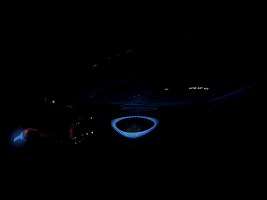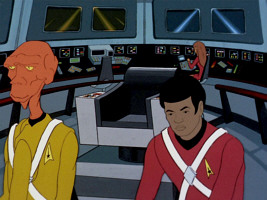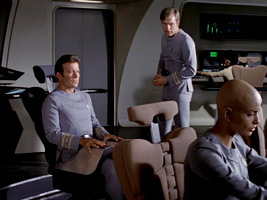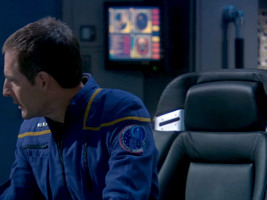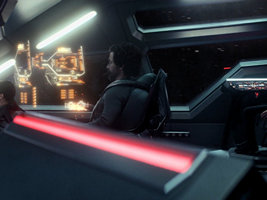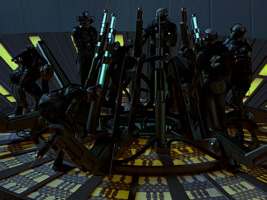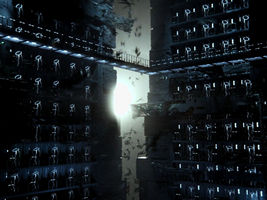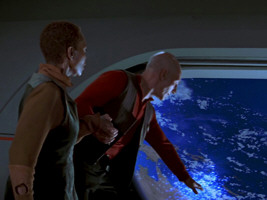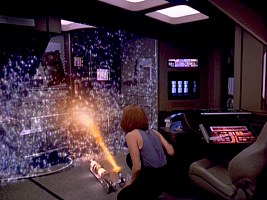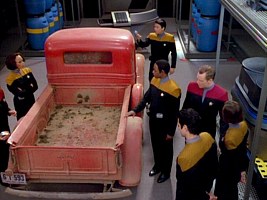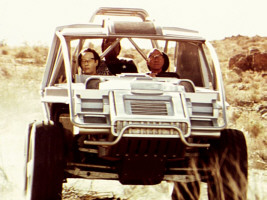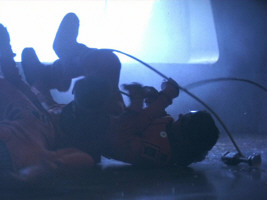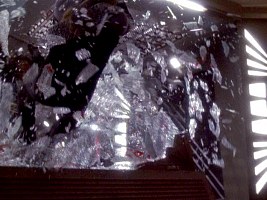Other Technology Inconsistencies
Ship SystemsMedical TechnologyMiscellaneous Technologies
Ship Systems
Structural integrity
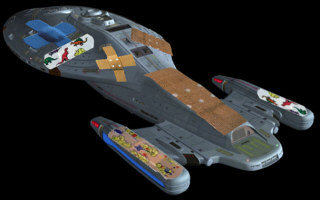 On Federation starships, there are three different systems that hold the hull together: the mechanical spaceframe, the structural integrity field (SIF) as an augment to mechanical stability and the inertial damping field (IDF) which counteracts acceleration forces. The SIF and IDF have both been mentioned on screen and in the TNGTM. The IDF is quite obviously necessary whenever the ship goes to warp or only impulse speed, in order to prevent the spaceframe, along with the crew, from being crushed. Even the strongest spaceframe made of sophisticated materials wouldn't sustain the push (or pull) from a propulsion system that could bring the ship to 0.5c in a matter of seconds.
On Federation starships, there are three different systems that hold the hull together: the mechanical spaceframe, the structural integrity field (SIF) as an augment to mechanical stability and the inertial damping field (IDF) which counteracts acceleration forces. The SIF and IDF have both been mentioned on screen and in the TNGTM. The IDF is quite obviously necessary whenever the ship goes to warp or only impulse speed, in order to prevent the spaceframe, along with the crew, from being crushed. Even the strongest spaceframe made of sophisticated materials wouldn't sustain the push (or pull) from a propulsion system that could bring the ship to 0.5c in a matter of seconds.
The question arises what the structural integrity field is still useful for. Although it is mentioned only in a side note in the TNGTM, it seems that this system needs to be activated all the time, maybe except for situations where no force acts upon the ship, like in orbit or after a "full stop" in open space. The SIF is definitely required when the ship is inside the dense atmosphere of a planet. But also in battles and when traveling at warp the SIF is often mentioned as a crucial system (typical quotes being something like "structural integrity at 20%" or "structural failure in 40 seconds"). Even if we don't know exactly if the structural integrity percentages refer to the strength of the SIF or rather to the measured deformation of the hull, it seems that the spaceframe alone wouldn't provide the sufficient stability of the ship even in standard situations.
It is understandable that above all the Galaxy class is a huge ship where, more than anywhere else, the scaling paradox applies, meaning that an exactly scaled up spaceframe will always be relatively weaker. On the other hand, we have sea ships on present-day Earth which are almost 500m long and which withstand not only the pull of gravity and water pressure, but are also designed to sustain the forces of storms. The hulls of such ships are made of 7.5cm to 15cm thick steel plates. The Enterprise-D, on the other hand, is still larger, but it consists of two separate parts which are the same order of size as a supertanker. With a relatively dense spaceframe compared to a sea ship and a hull plating of 30cm, made of duranium and other advanced materials, I would expect the Enterprise-D to be at least as stable as a sea ship of our days. Nevertheless, the authors of the TNGTM seemed to be a bit pessimistic about the ship's stability, thus the suggestion that the SIF is always needed. At latest in "Star Trek: Generations" it became obvious that the ship (at least the saucer) could endure a bit more than originally intended, as the saucer survived the impact without much visible structural damage.
Intra-ship transportation
We know from all Federation starships that the turbolift is the only regular means of transportation from one deck to another. There are vertical Jefferies tubes too, but they are very impractical and therefore only used in states of emergency, like in TNG: "Disaster" or TNG: "Starship Mine". In TNG: "Contagion" Data says that Dr. Pulaski is not trusting the turbolifts because of their malfunctions, "she is sending medical teams through the access tunnels" (where "access tunnels" obviously means the Jefferies tubes). In VOY: "Projections" Janeway (albeit not the real one) even pretends that without the turbolift it takes half an hour from the bridge to the galley one deck below! The question occurs if all ships shouldn't have staircases in addition to the turbolifts. After all, every building must have them too if the elevator should be out of order. Considering that the turbolift isn't more reliable than a present-day elevator, there should be stairs as a backup. They would come in handy too in situations too when many people are using the turbolift. Andrew Probert actually devised a staircase running through the spine of the Galaxy class (shown in The Art of Star Trek), but it never made it to the screen. The reason for that is probably that the set would have required a considerable height of three or more decks to look credible. Since it would have been an option to use it very often like in the above TNG episodes and also on Voyager in VOY: "Twisted" and "The Haunting of Deck Twelve", for instance, we have to assume that these ships actually don't have stairs.
Self-illumination
A starship in deep space would appear to us as a black silhouette with some lighted windows against an equally black background with stars. In order to allow the viewers to see the hull of the Enterprise nonetheless, special effects supervisor Douglas Trumbull and Enterprise designer Andrew Probert came up with the concept of self-lighting. They may have been inspired by the spotlights that use to illuminate the tail fins of commercial airplanes. So unlike it was with the pre-refit Enterprise of TOS, the ship's hull is not homogenously illuminated in "Star Trek: The Motion Picture", but it exhibits distinct spots of light. When the miniature with this built-in self-illumination was filmed, the production crew apparently relied on additional studio spotlights though. We recognize the self-illumination on most starships that appear in the four following TV series, albeit usually not with the same realism as in "Star Trek: The Motion Picture". The Starship Voyager, for example, often looks like diffuse light from a star is reflected from the hull when at warp, even though this would not be possible. In "Star Trek: The Wrath of Khan" the Reliant casts a shadow on the Enterprise's hull on their first encounter although it supposedly takes place in deep space. Also, the amount of self-illumination may have been reduced on more recent models compared to Probert's Enterprise. On many ships distinct spotlights seem to illuminate only key locations like the ship's registry.
The self-illumination fails on a couple of occasions. In TNG: "Where Silence Has Lease" the Enterprise-D is trapped in a "hole in space" that obscures the stars, and we can see that the ship's hull is pitch black for no apparent reason. The Enterprise-D is once again completely dark in TNG: "The Pegasus", while the vessel is passing a narrow channel into the cavity of an asteroid on the search for the missing ship Pegasus, although reflections from the rock walls should let it appear even brighter than in open space. We may rationalize the deactivation of the self-lighting in this case though, as the lights may have obstructed the short-range sensors. Voyager's exterior is dark in VOY: "Night", when the ship traverses a void, a vast region without stars. Only the Bussard collectors and the deflector dish cast faint lights on the hull. It is certainly a ridiculously flawed idea that remote stars could cast any visible light on a ship in deep space. Yet, in "Where Silence Has Lease" and "Night" it was probably decidedfor artistic license to enhance the effect of the plain black background by keeping the ship's hull black as well.
There is no good explanation for ships that are not illuminated just when stars are not visible either. It has to be a mere coincidence. Interestingly, when Voyager enters yet another void in VOY: "The Void", the error is not repeated and the self-illumination is active despite the void's notorious scarcity of energy.
And what about the cases in which the ships are devoid any self-lighting, like in TOS, or the lighting is incomplete, and yet their hulls appear bright? This may be a matter of suspension of disbelief rather than a technical issue. We may surmise that whenever the bridge crew looks at a vessel on the viewscreen the image is enhanced to exhibit more details than would be visible in open space. However, this cannot apply to external shots of starships that pretend to show them as if we would look at them with the naked eye, through the visor of a helmet. Almost all of these shots, which often serve as establishing or filler shots, are taken from positions where realistically no character is present and where no camera is installed. In this light (pun alert!) it does not make much of a difference whether there is only a candid camera to record a scene that only the TV audience could perceive like this, or a camera with an image enhancer to show the ship (s) in the scene in full glory.
Seatbelts
Ever since the TOS bridge crew was knocked off their seats whenever they ran into a space battle or into an anomaly, everyone wondered why there are no seatbelts on Starfleet ships. We wouldn't expect the whole bridge crew to be tied to their stations all the time (although it may be worth considering for helm, navigation and the later OPS officer). However, at latest when an enemy ship is approaching and red alert is issued, shouldn't this include fastening the seatbelts for anyone working on a specific console, everywhere on the ship?
There may be reasons not to have seatbelts. But the mere statistics of Starfleet officers losing control over their station, being injured or even killed because of missing seatbelts should disprove them, just like any scenario of dying in a car accident because the seatbelt can't be unfastened quickly enough is so unlikely that anyone not using it is a moron.
 In TAS: "Once Upon a Planet" we can see for the first time that the seats on the Enterprise bridge have seatbelts. This will remain a one-off exception for many years. Neither in the TOS movies nor in TNG, DS9 and Voyager any Federation ship is so equipped.
In TAS: "Once Upon a Planet" we can see for the first time that the seats on the Enterprise bridge have seatbelts. This will remain a one-off exception for many years. Neither in the TOS movies nor in TNG, DS9 and Voyager any Federation ship is so equipped.
The chairs on the refit Enterprise bridge in "Star Trek: The Motion Picture" at least have flippable armrests that can hold down a person's leg against the seat in cases of emergency. Kirk can be seen flipping down his armrests when the ship enters the wormhole. The same chairs can be found on the Stargazer, as seen in TNG: "The Battle".
In a deleted scene of "Star Trek Nemesis", seatbelts are being installed for the first time on Picard's command chair. The new captain's chair design with seatbelt slots would later appear on the NX class after the Xindi attack (ENT: "Home"). We never see the seatbelts though. Anyway, while the planned introduction of seatbelts finally corrects a perpetuated mistake, it makes the lack of low-tech safety measures on other ships even more noticeable.
In PIC: "Et in Arcadia Ego I", we can see that La Sirena is equipped with automatic seatbelts that fasten when the ship is attacked. So far, this is the only time in the fully canon Prime Universe continuity that seatbelts are shown.
 The chairs on the Enterprise bridge in the Kelvin Timeline have high-tech twin-shoulder seatbelts, whose segments unfold starting at the backrest in case of an emergency. The USS Franklin in "Star Trek Beyond" is also equipped with seatbelts, although the ship predates the timeline change.
The chairs on the Enterprise bridge in the Kelvin Timeline have high-tech twin-shoulder seatbelts, whose segments unfold starting at the backrest in case of an emergency. The USS Franklin in "Star Trek Beyond" is also equipped with seatbelts, although the ship predates the timeline change.
Medical Technology
Inoculations
It is an important achievement of modern medicine that many diseases may be averted through inoculations, generally by producing immunity against an infection by introducing small amounts of a pathogen. Star Trek Voyager frequently mentions an exotic variant, the so-called "inoculation against radiation", like in "Juggernaut", "One Small Step", "Inside Man", "Shattered", "Workforce" and "Endgame". In "Shattered" there is even an "inoculation" against time! The trend is continued in ENT: "Cogenitor". This sounds like absolute scientific nonsense. There is no biological method that could prevent radiation from being absorbed in the human body, because the latter is a merely physical process. Radiation simply doesn't involve any bacteria or viruses that could be fought in the blood stream. Any true protection against radiation from a simple protective cream to a sophisticated forcefield would have to keep the radiation from penetrating the skin in the first place. As soon as the radiation is being absorbed, it is already too late, and the consequences will range from immediate burns to mutations or other effects that are associated with the type of radiation. It is only possible that a special "inoculation" could prevent secondary damage somehow, or that it could help repair damaged cells. Still, in such a case it would be irresponsible to expose the body to it in the first place. As already said, a simple sun cream could do this job, or better a protective garment or one of the otherwise ubiquitous forcefields.
Similar nonsense can be found in TNG: "Conspiracy". Here it is the neural parasites that cause their host's glands to pour out adrenaline, thereby making it immune to phaser blasts except for an otherwise lethal setting. Clearly the mere presence of adrenaline in the blood could never prevent the skin burns that a phaser on high setting would definitely cause.
Addendum The idea of inoculations against radiation may not seem quite as absurd any longer in the light of the radiation resistance of a bacterium called Deinococcus radiodurans. This bacterium withstands higher doses of radiation than any other organism because of its protein repair mechanism. Speculation goes that this property might be incorporated in a genetic therapy for higher species some day. While this would not be an inoculation technically, it may explain what the Doctor really administers to his patients.
Borg in open space
"Star Trek: First Contact" shows the Borg, with their skin exposed to open space, working on the deflector dish of the Enterprise-E. If the Borg still have body functions like normal humanoids, they couldn't survive for long. The first problem is suffocation, of course. Human beings may lose consciousness after 15 seconds exposure to the vacuum because of hypoxia. But the respiration of the Borg may work differently. In fact, the readings of Borgified Earth in the same movie indicate "high concentrations of methane, carbon monoxide and flourine", which would be lethal to humans. The second issue is the pressure difference that is often said to make body fluids boil, and in many science fiction movies bodies exposed to a vacuum even explode. In fact, this process would be far slower and less dramatic in reality. It would be lethal, but not immediately. Furthermore, direct exposure to sunlight outside an atmosphere may cause severe sunburns. In order to survive the Borg may have some sort of sealing that maintains the pressure and temperature inside the skin and keeps the radiation away. Perhaps it is "only" a shield like the one that protects them from phaser fire too. Finally, in the absence of sunlight it seems like someone could die of the extremely low temperature in space. But the coldness of space isn't the real problem, because there is no heat conduction or convection that could drain heat energy from the body, and the radiation loss isn't that acute. If a human body should freeze in space, it's primarily because of evaporation.
So the metabolism of Borg probably works differently than that of humanoids and there may be fewer left of the original bodies than their look might suggest. But the Borg shields we have seen seem to be a specialized defense against beam weapons (as they are no help against holographic bullets or Worf's mek'leth). If the Borg don't anticipate or simply neglect sheer physical force from a species they want to assimilate, why should they care about an apparently unlikely situation like working in open space? Maybe they really routinely make repairs on their ships that way?
Several Borg are blown into space through an airlock in VOY: "Scorpion II". It is obvious they would only survive if they are located and rescued by a Borg ship. In PIC: "Broken Pieces", however, Narissa Rizzo jettisons all Borg drones that are still in their alcoves on the Artifact. Seven's reaction tells us that they would face certain death in open space. Also, rather than trying to rescue as many of them as possible after gaining control of the Artifact, she immediately sets a course to a transwarp conduit. So why did these Borg drones die, almost in an instant as it seems? Perhaps they were not prepared, not charged up sufficiently because they were is a deep sleep state?
Miscellaneous Technologies
Forcefields
Star Trek episodes often suggest that forcefields can easily be shaped so as to provide a flat surface and an abrupt border, most noticeably in about every holding cell since TOS, and as the "window" Picard shows to Lily in "First Contact". The force of real electromagnetic or gravitation fields, however, decays proportionally to 1/r^2 in a distance r from the source and never abruptly (see also shield inconsistencies). Sources from many directions would have to interact in order to create the flat forcefields usually seen in Star Trek. I think this would be overly complicated to accomplish something as simple as sealing a certain section against the vacuum of space or only keeping a prisoner in his cell. For a fixed installation, it may still be possible though. There are, however, some cases where forcefields are created from scratch, especially in VOY: "Extreme Risk", where B'Elanna manages to "project" a perfectly flat and thin forcefield inside the Delta Flyer. With only one improvised generator, this is definitely impossible.
Magnetic boots
The Federation has gravity and anti-gravity technology as well as tractor beams for at least 200 years, but boots for extravehicular activity still rely on a rather primitive magnetic effect in "Star Trek: First Contact", like already in "Star Trek: The Undiscovered Country". It is obvious that magnetic boots are inferior to what an (anti-) grav boots based on tractor beam technology could accomplish. Magnetic boots only work at distances very close to the hull, and only on magnetic hulls. There may be safety systems such as lifelines or engine packs in every spacesuit, but it could work much better if a balanced tractor beam inside the boots would maintain conditions more like in a real 1g environment. It is possible that a tractor beam generator, as opposed to simple gravity plating which would not be much different from magnetic boots, may be still a bulky and complex device that simply doesn't fit into the boots. On the other hand, Wesley builds quite a small and light tractor device in TNG: "The Naked Now" that could be used in boots as well.
Wheeled vehicles
In TOS: "A Piece of the Action" Kirk barely manages to drive a car. He is visibly unfamiliar with the ancient technology, and Spock even has to explain him a few basic controls. Still, we can assume that Kirk at least knows cars from history books and most likely he has seen one in a museum too. In this light it is very astounding that Harry Kim doesn't recognize a car at all when he sees one in VOY: "The 37's" (the rusty Ford pickup adrift in space). He speculates that it could be an early hovercar, as if he has never taken notice of 150 years of development of wheeled vehicles. And he is not kidding. At least Tom Paris is much more familiar with cars (as with anything from the 20th century), as we see him working on his holographic 1969 Chevy Camaro in VOY: "Vis à Vis". And Trip Tucker had a real car in the early 22nd century (ENT: "Precious Cargo"). So far it is just Harry's total ignorance which could be compared to a 21st century human searching for an engine in a wooden cart although he could clearly see that it is drawn by a horse.
But most surprisingly we see that Starfleet is using cars in the late 24th century again, namely Picard's Argo jeep in "Star Trek Nemesis". The Argo may be either Picard's personal fancy or an old technology that has been rediscovered by Starfleet without Harry's knowledge only recently. But by no means it appears to be practical in the age of perfectly controllable antigrav technology which could allow a shuttle could to hover centimeters above the ground without ever touching it. Sure, the Argo could have been devised for a first contact with a pre-warp civilization. But its usefulness would be very limited considering that an away team would have to keep a low profile and not arise attention with flashy equipment, even if it is appropriately old-fashioned on the pre-warp planet. In the case of Kolaren in "Nemesis" the Argo incidentally looks much like the indigenous vehicles and has similar capabilities. Two factions with the same kind of vehicles is a contrivance considering that we have seen lots of similar barren planets on Star Trek but never any remotely similar vehicles.
 A variety of wheeled vehicles is visible in "Star Trek (2009)", including a classic Corvette, a motorbike and a forklift. In the movie it is quite plausible that not every ground vehicle has to use antigrav technology like the police hoverbike, and that old cars and bikes may be kept operational for nostalgic reasons. In "Star Trek Into Darkness" we can see several cars with wheels in the streets of San Francisco.
A variety of wheeled vehicles is visible in "Star Trek (2009)", including a classic Corvette, a motorbike and a forklift. In the movie it is quite plausible that not every ground vehicle has to use antigrav technology like the police hoverbike, and that old cars and bikes may be kept operational for nostalgic reasons. In "Star Trek Into Darkness" we can see several cars with wheels in the streets of San Francisco.
 Lower Decks shows wheeled vehicles of Starfleet on multiple occasions, most notably in LOW: "Second Contact" and "An Embarrassment of Dooplers".
Lower Decks shows wheeled vehicles of Starfleet on multiple occasions, most notably in LOW: "Second Contact" and "An Embarrassment of Dooplers".
The hardest substance
Spock seems to change his mind more than once about what has to be considered as the hardest known substance. It looks like in this one matter we cannot take the science officer by his word.
- The outer protective layer of Earth Outpost 4, which was obliterated by the Romulans, was made of cast rodinium, "the hardest substance known to our science" according to Spock (TOS: "Balance of Terror").
- When Kirk finds deposits of diamonds on the planet's surface, Kirk himself calls them the "perhaps the hardest substance in the universe". When he builds his primitive blaster for the duel with the Gorn captain and fills the barrel with diamonds, Spock describes them with the words "the hardest known substance" (TOS: "Arena").
- The planet Argus X has deposits of tritanium ore, which Spock claims is "21.4 times as hard as diamond" (TOS: "Obsession").
While it would still let Spock's statements appear as unusually inaccurate, we may explain away the contradictions as follows. Rodinium and tritanium may be essentially the same substance and hence share their hardness. Perhaps they are two forms of the same chemical element if we can imagine that stable new elements will be discovered. Tritanium ore, for instance, may be the raw material for cast rodinium. On the other hand, the name tritanium will frequently reappear in Star Trek as a construction material for starship hulls, not as an ore. Perhaps the relation between rodinium and tritanium is rather like the one of iron and steel? They may be two alloys with different properties. We may fit in diamond as the hardest substance that occurs naturally, as this was the only thing that mattered when Kirk was isolated with the Gorn captain. Tritanium ore deposits certainly wouldn't have helped him, so Spock didn't bother to be more precise about the diamonds.
Side note In TNG: "The Arsenal of Freedom", Riker finds a fragment of molten tritanium, and Tasha states that this is beyond the capabilities of the Federation. Yet, we know that the Federation must be able to process tritanium for their ship hulls, of course including melting it. And since already Spock is aware of the hardness of tritanium, it is obvious that the Federation must have the knowledge to melt it, also because naturally occurring ore could hardly be 21.4 times as hard as diamond.
In addition, however, there are three more odd mentions of extremely hard materials:
- In the course of the episode Spock says about the Planet Killer, "Sensors show the object's hull is solid neutronium. A single ship cannot combat it... There is no known way of blasting through it... The object's neutronium hull makes sensor readings of the inner mechanism impossible" (TOS: "The Doomsday Machine"). If this is the same neutronium as in neutron stars in the sense of ultradense matter, it could not exist without the enormous pressure inside the star and would therefore explode. Anyway, it would be heavier and harder than any substance that can normally be found in space.
- Without even using a tricorder Spock recognizes the bars of the holding area built by the Kelvans as "somewhat like diburnium, but considerably more dense. I doubt even phaser fire could disturb its molecular structure" (TOS: "By Any Other Name"). Later in the same episode he states that the Kelvan power generator is "protected by a material we cannot breech, even with our phasers." This sounds a bit like his description of the planet killer and does not include a superlative though.
- The walls in the underground vault are described by Spock as "an alloy or substance completely unknown to me. Much stronger and harder than anything I've measured before" (TOS: "Return to Tomorrow"). Since this takes place after "The Doomsday Machine", this new material not only surpasses diamond, rodinium and tritanium, but even neutronium, if we believe his words.
Realistically neutronium cannot be ultradense matter from neutron stars. Not only the unknown builders of the Planet Killer, the equally unknown builders of the Dyson Sphere (TNG: "Relics") and the ancient Iconians (DS9: "To the Death"), but also some "ordinary" civilizations are using this substance, such as the Dominion (DS9: "What You Leave Behind"), the Vidiians (VOY: "Phage") and the Think Tank (VOY: "Think Tank"). It is noteworthy that the latter three mentions are all from newer DS9 and VOY episodes, indicating that until then neutronium was indeed considered to be a vastly advanced technology. Regarding the hardness of neutronium, Spock does not even use a superlative, but he just states that it is impenetrable using the ship's phasers or sensors.
This leaves the unnamed substance in TOS: "Return to Tomorrow" to be rationalized. It may be well possible that it is harder than either diamond or rodinium/tritanium, the materials known to the Federation. And with neutronium possibly being a less outlandish stuff than ultra-compressed matter, it is well possible that Spock never encountered something as hard as in Sargon's vault.
Glass everywhere
In "Star Trek: The Voyage Home" Scotty makes a big deal about transparent aluminum being superior to plexiglass, let alone glass, because it is much stronger and lighter. He even creates a temporal paradox by leaving the formula for the then unknown material in the late 20th century. Ironically, in the very same movie, we see how the window of Starfleet Headquarters in the 23rd century is being smashed due to the atmospheric conditions on Earth as if it were made of glass, and not even security glass. Likewise, several windows of the Enterprise-D saucer and the dome above the bridge break in the crash on Veridian III in "Star Trek Generations", something that never happened to any window in seven years in space battles and anomalies. In "Star Trek: First Contact" Borgified Lt. Hawk punches Capt. Picard's helmet shield that cracks like glass. Finally, while there are many examples of glass being used for furniture such as tables (TNG: "Conspiracy") or showcases ("Star Trek: First Contact"), the transparent display in DS9: "Tacking into the Wind" that is shattered during Worf's and Gowron's duel is apparently made of glass likewise.
It is obvious that glass would be still used in the future for mere decorational purposes. Transparent aluminum or similarly advanced materials may be more common only in safety-relevant applications. We don't actually know if and how transparent aluminum would have withstood the storm in "Star Trek: The Voyage Home" or the crash of the Enterprise-D in "Star Trek Generations". Maybe it was really transparent aluminum in both cases, and it was simply stressed beyond its rigidity, so much that it would break like the weaker glass. It may have been a quite thin pane in Starfleet Headquarters, not built for extreme weather conditions. And perhaps the Enterprise-D relies a bit too much on the IDF, SIF and shields, all of which were offline when the saucer went down. Still, there is the safety hazard that the supposed transparent aluminum of the future is smashed into thousands of sharp-edged pieces that could easily hurt or even kill someone, unlike today's security glass. This question remains unanswered.
Forgotten technologies
There were several sensational scientific discoveries and technical revolutions, which should have changed the Federation forever or at least ought to play an important role, but were never seen or mentioned again.
- Miri's planet: There were many planets very similar as Earth in TOS, but this one was an exact copy. It is safe to say that it must have been artificially created by some ancient powerful civilization. No one bothered to find an explanation it in the TOS episode "Miri" itself, and the planet was never heard of again.
- The Guardian of Forever: It was suggested that the gate might be used for time travels in the future (TOS: "The City on the Edge of Forever"), but (with the notable exception of the TAS episode "Yesteryear") was never seen or mentioned again. Maybe that was because of the Temporal Prime Directive though.
- The Planet Killer: The machine was destroyed in TOS: "The Doomsday Machine", but there was enough left of it to learn a lot from its technology and the impermeable neutronium hull.
- TOS androids: Data is always described as the only of his kind. This is in contrast to the various types of TOS androids that seemed to be almost as advanced as Data (TOS: "What are Little Girls Made of", "I, Mudd", "Return to Tomorrow", "Requiem for Methuselah"). Were they all scrapped, and why?
- Salubrious planets: Miri's Planet (TOS: "Miri") and Omega IV (TOS: "The Omega Glory") were discovered to have a life-prolonging effect on humanoids. Agreed, there were disastrous side effects, but curious and resourceful as Federation scientists are, maybe the problems could have been solved. Inhabitants of Platonius (TOS: "Plato's Stepchildren") have developed psychokinetic forces that were obviously without side effects. It is unlikely that this could have been kept secret for a long time, unless the Federation would have banned the planet like Talos IV. In the case of the Ba'ku homeworld ("Star Trek: Insurrection"), we may be sure that Picard will enforce that it will stay unharmed.
- Miraculous medical technology: The databank in TOS: "For the World is Hollow and I Have Touched the Sky" contained a cure for about every known illness. In TOS: "Spock's Brain", as silly as it may have been, there was detailed knowledge about to remove and return a humanoid brain without damage. Why didn't the Federation profit from all this knowledge?
- Shapeshifting: Captain Garth "learned" shapeshifting from the inhabitants of Antos IV (TOS: "Whom Gods Destroy"). Perhaps the people of Antos IV did something to his physiology, or they equipped him with a device that allowed him to change his cellular structure. But even though Garth killed the people on Antos IV who helped him, the technology has survived in his body. But perhaps it was rated as so dangerous that any information about it was kept top secret. Why aren't shapeshifters much more familiar anyway? Of course, it must be astonishing to see the shapeshifting of Martia in "Star Trek VI", Salia in TNG: "The Dauphin" or Odo's people, but each time this ability is treated like a myth, as if no records would exist of previous occurrences. Not to mention the shapeshifters who frequently appear as soon as in Star Trek Enterprise.
- V'ger: The gargantuan structure, along with Ilia and Decker, completely dissolved and obviously vanished into another dimension ("Star Trek: The Motion Picture"). Considering that V'ger is now "half-human", it could have been expected that it would show up again.
- The Genesis device: The device itself was flawed, and it might have been outlawed, also to appease the Klingons, but there is no way to deny that it basically worked ("Star Trek: The Wrath of Khan"). So why is terraforming in the 24th century (as shown in TNG: "Home Soil") still such a long and painful process? One possible explanation is that David Marcus admitted to using the highly unstable protomatter for which no replacement may have been found until the 24th century.
 The Genesis device finally reappears in LOW: "Parth Ferengi's Heart Place" and gets activated in "Old Friends, New Planets". It was miniaturized and sports a Ferengi interface.
The Genesis device finally reappears in LOW: "Parth Ferengi's Heart Place" and gets activated in "Old Friends, New Planets". It was miniaturized and sports a Ferengi interface.- The whale probe: The probe (from "Star Trek IV") traveled who knows how far only to make contact with the humpback whales, only to disappear into deep space again?
- Barclay's enhancements: In TNG: "The Nth Degree" Reginald Barclay gains incredible mental powers. He significantly improves many of the Enterprise's systems, including an increase of the shield power by 300%, direct control of the ship with thoughts and a propulsion system far in advance of current capabilities. None of these are ever seen again. Maybe the Cytherians removed every knowledge of all this, like they also returned Barclay to normal?
- The Dyson sphere: This is definitely the largest artificial structure by far to exist in the galaxy (TNG: "Relics"). The Federation has obviously taken custody of it, and fleets of research ships must have been examining the Dyson sphere. It is also likely that there would have been an intergalactic conflict about it. Why was it never mentioned again?
- The metaphasic shields: It was no problem to install these shields on a shuttle (TNG: "Suspicions") and later even on the Enterprise-D (TNG: "Descent"). Although obviously more powerful than conventional shields, they were never seen again.
- The Pegasus phasing cloak: This kind of cloak was obviously more advanced than the Klingon and Romulan cloaking devices, and it could be installed on the Enterprise in no time (TNG: "The Pegasus"). So why was it not employed for the Defiant or later in the Dominion War? The Romulans might have agreed to that. On the other hand, why was Admiral Pressman trying to salvage the prototype in the first place if he might have simply built a new device? Well, he may have been under the impression that the Romulans would soon discover it.
- The subspace transporter: DaiMon Bok used this device in TNG: "Bloodlines" to kidnap Jason Vigo, and Geordi quickly modified the Enterprise's transporter to beam over Picard to Bok's ship in the same fashion. If it is really as easy as making a few tweaks to a conventional transporter, why was this very technology never used on any other occasions, neither before nor after the episode? Well, the subspace transporter is said to be unreliable and to consume much energy. But in an emergency it may be absolutely justified to use it. The sub-quantum transporter that Emory Erickson was working on as soon as in the 22nd century may be just the same technology, and while it failed at that time there is no reason to get it to work some time in the following two centuries. Likewise, the Dominion transporter with its long range as shown in DS9: "Covenant" may be a subspace technology, but it is said to be beyond the possibilities of the Federation. Why? Ultimately even the so-called "transwarp beaming" of "Star Trek (2009)" may be essentially the same concept, although Spock says that Scott would develop it some day. Even if these technologies are undeveloped or only available to enemies in the required perfection, they remain singular although they realistically shouldn't.
- The Pegasus phasing cloak: This kind of cloak was obviously more advanced than the Klingon and Romulan cloaking devices, and it could be installed on the Enterprise in no time (TNG: "The Pegasus"). So why was it not employed for the Defiant or later in the Dominion War? The Romulans might have agreed to that. On the other hand, why was Admiral Pressman trying to salvage the prototype in the first place if he might have simply built a new device? Well, he may have been under the impression that the Romulans would soon discover it.
- The holographic communicator (24th century): The device aboard the Defiant seen only in DS9: "For the Uniform" (another holographic communicator was used on the station in DS9: "Dr. Bashir, I Presume") was not exactly revolutionary. Still, we have to wonder why the communicator that was obviously developed beyond prototype status and installed on at least two ships and the station was abandoned after what seems like just one week in service. As seem in DIS: "The Vulcan Hello", the technology already existed more than 100 years earlier.
 Holographic technology (23rd century): Starfleet routinely uses holographic communication in Star Trek Discovery, a technology that will obviously be abandoned, only to see a short revival in the 24th century on DS9 (see above). The series even shows a fully functional holodeck (DIS: "Lethe"), although this technology will be labeled as a major breakthrough more than 100 years later (TNG: "Encounter at Farpoint").
Holographic technology (23rd century): Starfleet routinely uses holographic communication in Star Trek Discovery, a technology that will obviously be abandoned, only to see a short revival in the 24th century on DS9 (see above). The series even shows a fully functional holodeck (DIS: "Lethe"), although this technology will be labeled as a major breakthrough more than 100 years later (TNG: "Encounter at Farpoint"). Replicated spacesuit helmets: A few years after DIS: "Brother", Starfleet will have forgotten the technology of spacesuit helmets that are replicated on voice command, and will never have anything remotely as advanced again, not even over 100 years later.
Replicated spacesuit helmets: A few years after DIS: "Brother", Starfleet will have forgotten the technology of spacesuit helmets that are replicated on voice command, and will never have anything remotely as advanced again, not even over 100 years later. The spore drive: The revolutionary discovery that the spore network runs through the whole universe and that it enables almost instantaneous travel to any point in the galaxy is never used or only mentioned again. This is explained in DIS: "Such Sweet Sorrow II" as being a banned technology.
The spore drive: The revolutionary discovery that the spore network runs through the whole universe and that it enables almost instantaneous travel to any point in the galaxy is never used or only mentioned again. This is explained in DIS: "Such Sweet Sorrow II" as being a banned technology. The time travel suit and time crystals: While the "Red Angel" suit falls under the ban of "Such Sweet Sorrow II", there is no reason why the Klingon time crystals would never even be mentioned again.
The time travel suit and time crystals: While the "Red Angel" suit falls under the ban of "Such Sweet Sorrow II", there is no reason why the Klingon time crystals would never even be mentioned again.
We may suppose that some of the above discoveries didn't turn out useful, were declared top secret or off limits (Guardian of Forever, Miri's planet, several of the numerous Discovery anachronisms) or were outlawed (Genesis device).
Credits
Some screen caps from TrekCore. Thanks to Bas Gorris for some suggestions about structural integrity and the turbolift/staircase issue, to fastkid for bringing up the seatbelt issue, to Daniel for the hint about the armrests in TMP, to Carsten and Robert Heckadon for raising the "Borg in space" problem, to NDR for a suggestion about inoculations, to James for digging up the radiation-resistant bacterium, to USS Paladin, Marc Eaden, Richard Watt, sciguy, POTUS and Martok for suggestions about abandoned technologies, to Jason McNulty for reminding me of Wesley's tractor beam emitter and to Earl for suggestions about wheeled vehicles.






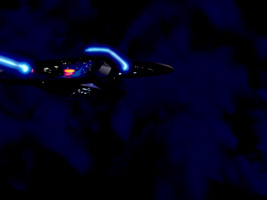
 Enterprise in the dark in TNG: "Where Silence Has Lease"
Enterprise in the dark in TNG: "Where Silence Has Lease"